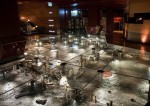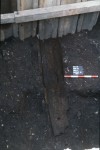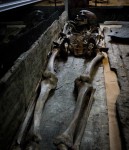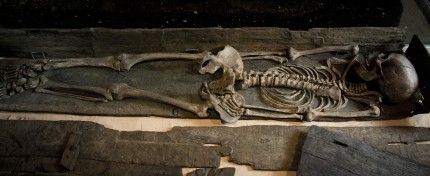 York was occupied by Vikings from 866 A.D. until the Anglo-Saxon King Eadred defeated Eric Bloodaxe, the last Viking ruler of York, in 954 A.D. and united England into a single kingdom. When the Vikings arrived, the Anglo-Saxon port city of Eoforwic was in decay. They renamed it Jorvik and developed it into a thriving center of trade with Viking Scandinavia and Dublin, the Byzantine Empire and the merchant networks of the Silk Road. Despite this rich history, what little evidence of Viking material culture surfaced in York was discovered by accident. The first professional excavation by the newly founded York Archaeological Trust only took place in 1972, and that was just a few small trenches dug under Lloyds Bank on Pavement. The trenches were unexpectedly productive, revealing up to 30 feet of archaeological layers and proving that the waterlogged, peaty soil of York was an excellent preserver of organic remains like timber, textiles, leather, seeds, plants, pollen, human parasite eggs and insects, an invaluable source of information about people’s daily lives in Jorvik.
York was occupied by Vikings from 866 A.D. until the Anglo-Saxon King Eadred defeated Eric Bloodaxe, the last Viking ruler of York, in 954 A.D. and united England into a single kingdom. When the Vikings arrived, the Anglo-Saxon port city of Eoforwic was in decay. They renamed it Jorvik and developed it into a thriving center of trade with Viking Scandinavia and Dublin, the Byzantine Empire and the merchant networks of the Silk Road. Despite this rich history, what little evidence of Viking material culture surfaced in York was discovered by accident. The first professional excavation by the newly founded York Archaeological Trust only took place in 1972, and that was just a few small trenches dug under Lloyds Bank on Pavement. The trenches were unexpectedly productive, revealing up to 30 feet of archaeological layers and proving that the waterlogged, peaty soil of York was an excellent preserver of organic remains like timber, textiles, leather, seeds, plants, pollen, human parasite eggs and insects, an invaluable source of information about people’s daily lives in Jorvik.
 The York Archaeological Trust (YAT) performed the first planned excavation in 1976 in Coppergate, the city’s ancient center, which was slated to be redeveloped into an open-air shopping center. From 1976 through 1981, the Trust excavated more than 1,000 square metres and 2,000 years of history. The remains of an entire street of Viking York survived thanks to the magic of peat: timber buildings, woven wattle used to make walls and pathways, fences, animal pens, shop fronts, artisan workshops, cesspits and wells. More than 40,000 objects were unearthed in the Coppergate excavation and more than 500,000 people visited the site during the dig.
The York Archaeological Trust (YAT) performed the first planned excavation in 1976 in Coppergate, the city’s ancient center, which was slated to be redeveloped into an open-air shopping center. From 1976 through 1981, the Trust excavated more than 1,000 square metres and 2,000 years of history. The remains of an entire street of Viking York survived thanks to the magic of peat: timber buildings, woven wattle used to make walls and pathways, fences, animal pens, shop fronts, artisan workshops, cesspits and wells. More than 40,000 objects were unearthed in the Coppergate excavation and more than 500,000 people visited the site during the dig.
 The excavation was incorporated into the new development. It became part of the Jorvik Viking Centre, visible through the transparent floors of the museum which recreated the Viking city with period-accurate structures, manikins with faces recreated from 9th and 10th century skulls, and my favorite part, the pungent smells of Viking York which came highly recommended by SourceRunner and Duncan Armitage in this comment thread.
The excavation was incorporated into the new development. It became part of the Jorvik Viking Centre, visible through the transparent floors of the museum which recreated the Viking city with period-accurate structures, manikins with faces recreated from 9th and 10th century skulls, and my favorite part, the pungent smells of Viking York which came highly recommended by SourceRunner and Duncan Armitage in this comment thread.
 The York Archaeological Trust had another archaeological coup between October 1989 and July 1990 when it excavated graveyard of the lost church of Saint Benet in the Swinegate area of York. The church had stood on the site from the 8th century through the 14th, and archaeologists discovered more than 100 burials from the churchyard. A number of burials dated from Viking era — late 9th to the early 11th century — and included the exceptionally preserved remains of wooden coffins and lids.
The York Archaeological Trust had another archaeological coup between October 1989 and July 1990 when it excavated graveyard of the lost church of Saint Benet in the Swinegate area of York. The church had stood on the site from the 8th century through the 14th, and archaeologists discovered more than 100 burials from the churchyard. A number of burials dated from Viking era — late 9th to the early 11th century — and included the exceptionally preserved remains of wooden coffins and lids.
 One of these Viking-era burials from the Swinegate excavation has now gone on display in its wooden coffin at the Jorvik Viking Centre. This is the first time any of the Swinegate skeletons or coffins has gone on public display.
One of these Viking-era burials from the Swinegate excavation has now gone on display in its wooden coffin at the Jorvik Viking Centre. This is the first time any of the Swinegate skeletons or coffins has gone on public display.
The condition of the wood gives this coffin national significance, as so few similar examples exist – particularly as this coffin would have been fairly fragile when first constructed, which tells archaeologists that it would have only been transported a short distance for burial. The coffin was made for a young woman, estimated at being aged between 26 and 35. Recent analysis of the bones reveals some of her life story– including that she had inadequate nutrition or disease as a child and degenerative joint disease in the spine and hips – but there is no indication of the cause of her death.
Over the last few weeks YAT’s conservation team have undertaken a thorough examination of the coffin to determine its structure and reveal how it was constructed. “The coffin is made from oak with pegged fastenings, and you can see that during construction, the piece of timber used for the lid of the coffin split and was repaired using a baton fastened inside, with the pegs cut flush on the outer surface to make the repair less obvious,” adds Sarah.
 You can read the full reports of the 2015 reinvestigation of the skeletal remains and wood coffins on the York Archaeological Trust website. I particularly enjoyed the Woodworking Technology Report (pdf) and the Osteological Analysis (pdf).
You can read the full reports of the 2015 reinvestigation of the skeletal remains and wood coffins on the York Archaeological Trust website. I particularly enjoyed the Woodworking Technology Report (pdf) and the Osteological Analysis (pdf).
The skeleton and coffin display is the vanguard of the Jorvik Viking Centre’s commemoration of the thousand year anniversary of King Canute’s accession to the throne of England in 1016. The Canute Millennial celebrations will kick off during next year’s 32nd annual Jorvik Viking Festival in February. If you’re in York for the festivities, there will be a lecture event at the Jorvik Viking Center on February 17th, 2016, at 7:00 PM about the skeleton and her coffin. York Archaeological Trust conservator Steve Allen will discuss the coffin, while osteoarchaeologist Malin Holst will talk about the skeleton.
